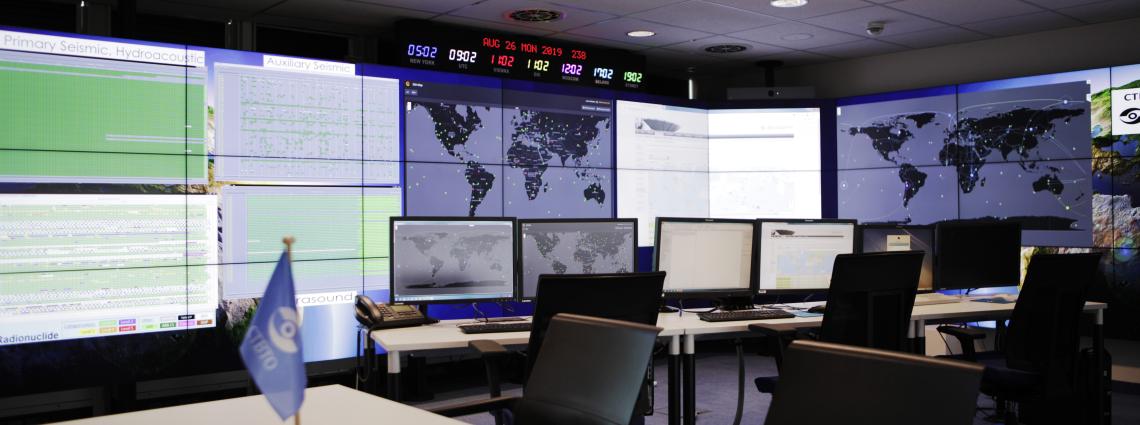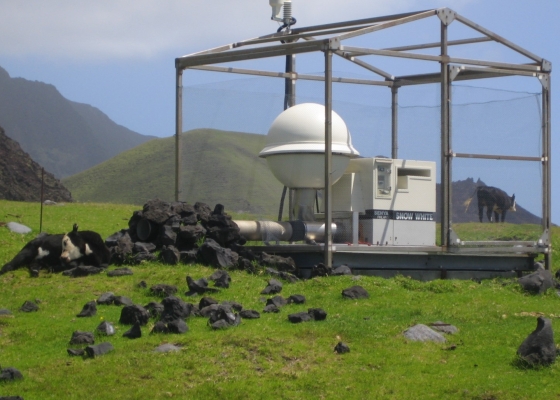International Data Centre
Providing the Information Member States Need
Data are at the core of the CTBT’s verification efforts. Their analysis at the International Data Centre (IDC) provides the information that Member States need to establish whether an ambiguous event has taken place, and whether such an event may indeed have been a nuclear explosion.
Located in the CTBTO’s headquarters in Vienna, the IDC collects, processes and analyses monitoring data from more than 300 facilities in the International Monitoring System (IMS), and distributes them to Member States in both raw and analysed form. A mass storage system in its computer centre provides archiving capacity for all verification data, now dating back over two decades.
It is often emphasised that the data belong to the Member States. A State Signatory has the right of full access to all monitoring data and data bulletins, which can assist a country in exercising its prerogative to make the final judgement in the case of a suspicious event.
For Member States to be able to come to an informed judgement, they need to have at their disposal all raw data and data analysis results in a reliable, equal and timely fashion. The IDC makes sure that these requirements are met.
Within just hours of a suspected nuclear test, all Member States receive information about the location, magnitude, time and depth of the event, followed by further analysis and any later detection of radionuclides that may indicate a nuclear explosion.
A Member State’s access to monitoring data and analysis reports is ensured through a secure signatory account with the CTBTO, through which authorised users can communicate with the IDC and transfer data securely.
To facilitate technical interaction, Member States are encouraged to establish a national data centre (NDC) to obtain, examine and analyse all necessary information provided by the IDC. In countries that host IMS stations, the NDC can play a key role in facilitating the operation of these stations and the transmission of monitoring data to the IDC.
NDCs are usually institutions specialising in verification technologies, such as a national earthquake institution or a nuclear radiation monitoring agency. In some cases, several institutions jointly assume the functions of an NDC. The exact mode of operation is defined by the Member State itself, according to national needs.
Since not all Member States have the technical or personnel capacity to establish an NDC, the CTBTO also provides technical assistance to enable them to receive monitoring data and IDC products. This assistance includes distributing and help with installing an NDC software package, or ‘NDC in a box’, to receive, work with and analyse the data.
Training courses for NDC staff and IMS station operators familiarise participants with the CTBT verification regime and its functioning, as well as the operation of an NDC and the handling of all relevant software, analysis and station equipment.
Processing and analysing the data
The IDC draws on the four IMS monitoring technologies to detect possible nuclear explosions: seismic, hydroacoustic, infrasound and radionuclide.
Three of these – seismic, hydroacoustic and infrasound – monitor waveform data from seismic and acoustic waves that move through the Earth, the oceans and the atmosphere. Waveform data help to identify the location of an event and to qualify it as either natural or potentially of human origin.
However, they cannot reliably indicate whether a non-natural event, such as an explosion, was nuclear or not. The IDC therefore also relies on radionuclide monitoring data to trace and analyse potential radioactive particles and gas that could provide proof of a nuclear explosion.
The flood of data arriving 24/7 at the IDC must be screened, first automatically by specially designed computer programmes and then by experts, to identify events that require further attention and analysis.
Data from single waveform monitoring stations are analysed individually in an automatic process to detect relevant signals. The next step is the highly complex task of sorting out which signals from different stations originate from the same event.
Based on this automatic analysis, a series of Standard Events Lists (SELs) are issued to Member States one hour, four hours and six hours after an event as more information is received from monitoring stations. The first of these, SEL1, includes data from primary seismic and hydroacoustic stations. Based on this, additional data may be requested from auxiliary seismic stations, which feed into SEL2 along with infrasound data. The third list, SEL3, adds any further data received.
The results of this automatic processing still need to be reviewed and refined by analysts to provide reliable and comprehensive information. Analysts carry great responsibility; they work against tight deadlines and must have experience, good judgement and sharp detecting skills. Within two days of the event, their review is issued as a Reviewed Event Bulletin, providing Member States with comprehensive information based on data from the IMS waveform networks.
Because radionuclides must travel through the air to reach IMS radionuclide stations, timelines for detection and analysis depend crucially on prevailing global wind patterns. The dispersion of radioactive particles and noble gas generated by an event can take days or even weeks before reaching a monitoring station, long after the waveform data for the same event have been analysed.
Once radionuclides arrive at a monitoring station, radionuclide data sampling, measurement, data transmission to IDC and data processing take a minimum of two days, resulting in an Automatic Radionuclide Report. Within approximately three days of sample collection, a Reviewed Radionuclide Report (RRR) is available based on expert review.
Since radionuclide technology does not provide any information on the possible location of an event, analysts use atmospheric transport modelling (ATM) based on high-quality global meteorological data to trace various travel paths from any station where a radionuclide was detected back to the area where it may have originated. This process can also be reversed to predict where radionuclides from a possible nuclear explosion at a given location would be expected to travel.
Operations Centre: the nerve centre of the system
An average of more than 30 gigabytes of data are transmitted every day, from the monitoring stations to the IDC and from the IDC to Member States. The Operations Centre at the CTBTO headquarters in Vienna controls and manages this task by monitoring all data traffic, playing a key role in ensuring that high quality and reliable products of data processing and analysis are made available to the Member States in a timely fashion.
On large, wall-mounted monitors, staff can observe data coming in from all stations of the International Monitoring System (IMS), as well as the progress of automatic processing of waveform data from seismic, infrasound and hydroacoustic stations. Different colours signify the status: arrival, data masking – a process of assessing the usefulness of data for further analysis – and any missing data.
A separate screen shows the connections to auxiliary seismic stations, which send data on request only. Again, colour coding provides an immediate overview of the status.
Any failure in data transmission is analysed and a troubleshooting process is initiated to address the situation and take corrective action. The reasons for such a failure can be diverse, ranging from technical malfunctions to power outages and even animal activity, such as rodents eating cables or cable insulation.
The communication between monitoring stations and the Operations Centre works in both directions: the Operations Centre may contact an IMS station to clarify a question, and acts as a focal point for station operators on all matters relating to station operation.
Fast and secure: the Global Communications Infrastructure
While monitoring the flow of information from monitoring stations, the Operations Centre also keeps an eye on the Global Communications Infrastructure (GCI), the CTBTO’s dedicated network that forms the backbone of data transmission to and from the International Data Centre.
The GCI is truly global in nature, stretching from the Antarctic to the Arctic and using a combination of communications technologies including satellite, cellular, internet and terrestrial communication links.
The current, third generation of the GCI began operation in 2018. With target availability of between 99.5% and 99.95% for individual links, depending on the technology, it is required to deliver data from transmitter to receiver within seconds. To ensure that the transmitted data are authentic and have not been tampered with, it uses Global Positioning System (GPS) timestamps, digital signatures and keys. Increasingly, the GCI is also being used as a means for the CTBTO and station operators to monitor and troubleshoot IMS stations remotely.
IMS facilities, the IDC and Member States can exchange data via their local earth station fitted with a Very Small Aperture Terminal (VSAT), through one of several commercial geostationary satellites. The satellites route the transmissions to hubs on the ground, and the data are then sent to the IDC via terrestrial links. In situations where VSATs are not in use or are not operational, other technologies such as broadband global area networks (BGANs), 3G/4G or virtual private networks (VPNs) can provide alternative routes, with specialised protocols to support secure encrypted communications.
The network connects over 300 IMS facilities and more than 100 NDCs and national tsunami warning centres. In addition, over 70 independent subnetwork links and 6 Antarctic communication links are operated by 10 States Signatories to carry IMS data to a GCI connection point. In total, the combined networks have over 600 different communication links to transport data to and from the IDC.



